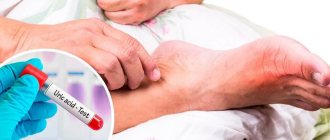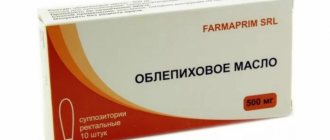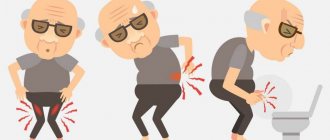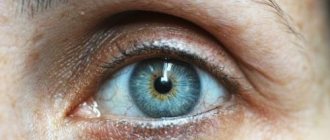Home » Hemorrhoids » Chronic hemorrhoids
Sign up for a consultation with a proctologist for the treatment of hemorrhoids for 3,500 rubles and receive a treatment prescription within 30 minutes for 1 appointment
Find out what day you need to make an appointment to get a consultation without a queue.
Experience 44 years 73 operations per month 876 operations per year 171 reviews Author of 73 scientific papers Has 9 patents 6,818 requests per month
Call
Chronic hemorrhoids are an expansion of the venous plexus that occurs over a long period of time. Initially, the patient is diagnosed with an acute form of pathology, which, if left untreated, develops into chronic hemorrhoids. Venous plexuses are located in the submucosal layer of the lower rectum and in the subcutaneous area near the exit from the anus.
Proctological disease is accompanied by anal bleeding and an increase in the size of hemorrhoidal cones. The tumors bleed, become inflamed and fall out of the anus, which brings discomfort to the patient. Itching and burning in the anus, pain syndrome appears.
Chronic hemorrhoids of any degree are diagnosed after obtaining anamnesis and information about symptoms.
Medical statistics
Chronic hemorrhoids are considered a chronic pathological phenomenon, which is accompanied by an increase in the arteriovenous cavernous plexuses in the anus. Accompanied by anal bleeding, thrombosis and anemia as a result. Hemorrhoids fall out and become pinched. Hemorrhoids are the most common disease in the field of proctology. Pathology is diagnosed in 14.5% of the population of the Russian Federation. Men who work physically are at risk.
According to medical statistics, 80% of patients seek help when the situation worsens. In the early stages, the disease does not manifest itself in any way, so it is almost impossible to identify it without diagnostic tests. Hemorrhoids are usually detected during a routine medical examination.
Causes
Proctologists identify a number of reasons that provoke the development of hemorrhoids. These include genetic predisposition. In this group of the population, increased intra-abdominal pressure and impaired functioning of the esophagus are observed in utero. Experts call a sedentary lifestyle one of the main reasons. An unbalanced diet, disrupted daily routine and lack of normal sleep lead to a deterioration in metabolism, which provokes an increase in hemorrhoidal cones. Heavy physical activity and gastrointestinal disorders are among the factors that influence the appearance of chronic hemorrhoids.
More often, the disease is diagnosed in people who often strain during bowel movements, and in those who suffer from multiple bowel movements. Feces come out of the rectum several times at intervals of several minutes. Accelerating bowel movements by pushing leads to the formation of anal fissures and scars. In women, hemorrhoids develop during pregnancy, as the uterus puts pressure on the internal organs. The abdominal organs are especially affected by intra-abdominal pressure.
Causes of hemorrhoids
The development of the disease is promoted by many reasons, including hereditary predisposition, excess weight, physical inactivity or bad habits. In addition, hemorrhoids often result from professional activities associated with prolonged exposure to one position (pilots, drivers, office workers, etc.). Various disturbances in the functioning of the intestines, caused by poor nutrition and abuse of spicy, fatty, fried foods, and fast food, are a provoking factor of the disease. In women, the disease most often progresses during pregnancy and childbirth, and in men, the development of the disease can be caused by a passion for strength training and lifting weights.
At the second stage of hemorrhoids, patients often seek medical help, because the disease brings significant discomfort and its symptoms can no longer be ignored.
Pathogenesis
Proctological disease develops when the arteriovenous cavernous plexuses increase and form during intrauterine development. Outwardly they resemble the corpora cavernosa of the genital organs. The plexuses are located above the dentate line or on the mucous membrane in the lower rectum. They are also localized under the dentate line, in the subcutaneous tissue in the anal canal. The plexuses are connected to each other using anastomosis.
The corpora cavernosa in the anus fill with blood and are responsible for sealing the closed sphincter. Previously, proctologists believed that chronic hemorrhoids develop due to varicose veins in the affected area. Today, there are a number of factors that influence the impaired functioning of internal organs. These include an increased amount of blood in the corpora cavernosa, as arterial inflow accelerates. Venous outflow slows down. Thrombosis forms, which leads to anemia, and the vascular wall of the anus becomes inflamed.
The superior rectal artery becomes wider than in healthy people. The number and density of blood vessels in the anal area increases. Muscles and veins weaken, become thinner, and worn out. Hemorrhoids enlarge and prolapse from the rectum. When defecating, the patient strains, thereby putting pressure on the exit of feces. Nodes move in the wrong direction.
Stages of hemorrhoids
Depending on the course of the disease, the following stages are distinguished:
- hemorrhoids of the 1st degree - drip bleeding from the anus opens. Pain syndrome appears in the anal area. Hemorrhoids are small, so they do not fall out of the rectum. The vascular pattern of the mucous membrane is enhanced. Pathological changes in the muscular-ligamentous framework develop;
- hemorrhoids of the 2nd degree - heavy bleeding opens, itching and burning appears in the anus. Mucus is released, the size of hemorrhoids is rapidly growing. The tumors fall out, but the patient can set them back without the help of a medical specialist. Dystrophic changes in muscles are observed;
- Hemorrhoids 3rd degree - hemorrhoids fall out after each bowel movement. The patient tries to move them inside on his own. Muscles become less elastic, ligament and muscle degeneration progresses. Pain increases even in a sitting position;
- hemorrhoids of the 4th degree - the pain intensifies, discomfort is present even in a sitting position. Fecal incontinence begins. Hemorrhoidal cones fall out when walking, coughing and sneezing. Severe muscle dystrophy is diagnosed.
You should contact a proctologist as early as possible in order to begin treatment at the initial stage of hemorrhoids and avoid complications.
What does external hemorrhoids mean?
External hemorrhoids are characterized by prolapse of hemorrhoids with the impossibility of their reduction into the anus.
Acute external hemorrhoids
Sudden appearance of formations in the anal area.
Thrombosis is a painful, dense, dark blue formation in the area of the hemorrhoid, caused by impaired nutrition and circulation of the pathologically enlarged vein.
Stages of acute external hemorrhoids:
- Thrombosis of hemorrhoids without signs of inflammation;
- Thrombosis with inflammatory reaction;
- Thrombosis of nodes with their severe inflammation and its transition to subcutaneous fat, swelling of the skin in the anus, necrotic lesions of the mucous membrane of hemorrhoids.
Chronic hemorrhoids, symptoms
Initially, the patient is diagnosed with an acute form of hemorrhoids, which soon becomes chronic. The patient feels discomfort when defecating, pain appears in the anus. Every day the pain intensifies. Profuse bleeding with impurities of pus and mucus appears. Hemorrhoids are damaged by feces during bowel movements, resulting in bloody discharge and clots from the anus. The color of blood is bright scarlet. Discharges flow from the arteries that supply blood to the arterial and venous cavernous plexuses.
If blood remains in the rectum, it comes out after bowel movements in the form of dark clots and mucus.
Symptoms of hemorrhoids differ depending on the stage and course:
| Initial stages | Late stages |
| Bleeding is not profuse. Occurs with an unbalanced diet and constipation. The symptom disappears on its own without the help of a medical specialist. The patient notices discharge on underwear, on the bed, on toilet paper. Appear by drip or small stream. | Bleeding is considered profuse. Appears after each act of defecation and even when walking and during physical activity. Pus and mucous discharge are released. The patient seeks help from a proctologist, as the profuseness intensifies. Bleeding leads to iron deficiency anemia or anemia. Heavy discharge is observed more often in the male half of the population. |
| The size of hemorrhoids is small, however, they can be felt by palpation. They are elastic and do not fall out of the anus. The size of the neoplasms is 2 centimeters. Palpation does not cause discomfort and is considered painless. | In advanced stages, the size of hemorrhoids increases, and prolapse from the rectum is observed. Palpation becomes painful and uncomfortable. |
| The pain syndrome is present only during bowel movements and does not bring severe discomfort to the patient. There is a burning and itching sensation in the anus. | The intensity of the pain increases, the itching does not go away even in a sitting position. The patient notices a pulsating sensation that intensifies with movement and coughing. Sleep is disturbed. |
A large amount of mucus is released from the anal area. Itching appears due to dermatitis, which develops as a result of taking medications. Soft tissues become dense, inflamed and swollen.
In some cases, an increase in temperature and blood pressure is observed. Appetite disappears, the patient feels tired.
Hemorrhoids: causes, symptoms, diagnosis and treatment approaches
The term “hemorrhoids” comes from the Greek words “haema” - blood and “rhoos” - flows and was first found in the writings of Hippocrates when describing bleeding from the anus [1]. The disease is mentioned in ancient medical works of various cultures, Babylonian, Hindu, Greek, Egyptian.
Being a widespread disease, occurring in 36% of the population of economically developed countries, hemorrhoids rank first in the structure of proctological diseases [2]. A significant number of patients are young and of working age, which indicates the significant social and economic significance of the problem under consideration.
For many years, there has been a theory of varicose veins, which states that hemorrhoids develop due to varicose veins in the anal canal. Today it has been proven that the formation of hemorrhoids includes a wide range of pathological changes, including venous dilatation, vascular thrombosis, degenerative changes in collagen fibers and fibroelastic tissues, deformation and rupture of the anal subepithelial muscle [3, 4]. An additional aggravating factor is the addition of inflammatory changes in the vascular wall and surrounding connective tissue. Recent data show the participation of a number of enzymes, primarily matrix metalloproteinases (MMPs) and zinc-dependent proteinase in the degradation of connective tissue and the destruction of extracellular matrix proteins (elastin, fibronectin, collagen). The role of MMP-9 in the destruction of elastic fibers has been established [4]. Activation of MMP-2 and MMP-9, thrombin, plasmin or other proteinases is accompanied by disruption of capillary blood flow and activation of transforming growth factor β (TGF-β) [5]. Hypervascularization and increased microvascular density are an important pathogenetic factor in hemorrhoids. [6]. Microvascular density increases in hemorrhoidal tissues. An increase in the level of endoglin (one of the TGF-β binding sites) is a marker of vascular proliferation [7]. It has been shown that the diameter of the superior rectal artery in patients with hemorrhoids has a significantly larger diameter and a higher peak blood flow velocity compared to healthy individuals. These changes persist even after surgical treatment of hemorrhoids [8, 9].
There is a connection with defecation disorders, in particular with stool frequency [10–12]. Data on the role of dietary factors, including low protein diet, consumption of spicy foods, and alcohol, remain controversial [13].
At the present stage, the following are considered as the main mechanisms for the development of hemorrhoids (L. L. Kapullera (1974), G. I. Vorobyova et al. (2002)):
- Vascular dysfunction caused by increased arterial blood inflow and decreased outflow through the cavernous veins.
- Dystrophic processes in the common longitudinal muscle of the submucosal layer and the ligament of Parks, which hold the cavernous plexus in the anal canal.
- Destruction of the fibromuscular framework of the internal hemorrhoids, holding them in the anal canal above the anorectal line, combined with increased arterial blood flow, an increase in the size of the hemorrhoids, displacement in the distal direction and, ultimately, prolapse from the anal canal.
Loss of elasticity leads to mobility of hemorrhoids, which, under the influence of pressure in the rectum, begin to move towards the anal canal (if problems arise with emptying the rectum and constipation). In advanced stages, the suspensory ligament and Parkes' ligament rupture and the internal hemorrhoids begin to prolapse.
Classification of hemorrhoids
In practice, the following four categories of hemorrhoids are most often used:
1) acute/chronic; 2) external/internal; 3) complicated/uncomplicated; 4) stage of hemorrhoids according to the degree of prolapse and reducibility of the nodes.
In the International Classification of Diseases ICD-10 (1995, WHO, Geneva), the following forms of hemorrhoids are distinguished in the section of venous diseases:
- I 84 hemorrhoids;
- I 84.0 internal thrombosed hemorrhoids;
- I 84.1 internal hemorrhoids with other complications (bleeding);
- I 84.2 internal hemorrhoids without complications;
- I 84.3 external thrombosed hemorrhoids;
- I 84.5 external hemorrhoids without complications;
- I 84.6 residual hemorrhoidal marks;
- I 84.7 thrombosed hemorrhoids, unspecified;
- I 84.8 hemorrhoids with other complications, unspecified;
- I 84.9 hemorrhoids without complications, unspecified.
Clinical manifestations of hemorrhoids
The most common presentation of hemorrhoids is rectal bleeding associated with bowel movements, described by patients as "having a drop of blood in the toilet." Blood is typically bright red in color [13–15]. A typical symptom complex of the chronic course of the disease consists of repeated bleeding, usually associated with defecation, prolapse of hemorrhoids from the anus during and after defecation, and pain in the anus. Bleeding from the anus is observed in 76% of patients. Prolapse of hemorrhoids (as the first symptom) is observed in 39% (G. I. Vorobyov, 2006). Hemorrhoidal bleeding usually occurs during bowel movements. In this case, scarlet blood is released from the anal canal in the form of frequently dripping drops after defecation, separately from the intestinal contents. Sometimes blood appears in streaks in the stool. Relatively rarely (in 10% of cases) bleeding is permanent. In even rarer cases, blood may stagnate in the rectum, and clots and dark red blood may be present. The volume of blood loss can vary significantly. Blood may be barely noticeable on toilet paper, or it may splatter on the toilet. Before claiming that this is hemorrhoidal bleeding, it is necessary to perform an irrigation and colonoscopy, which will exclude all other causes of bleeding, especially colon tumors.
A positive stool occult blood test or the presence of anemia are usually not associated with hemorrhoids and require the exclusion of a number of bowel diseases, including colorectal cancer.
Pain is not a characteristic sign of chronic hemorrhoids. However, if pain occurs, it is necessary to determine its type, find out whether it is acute or chronic and how its intensity manifests itself during rectal emptying. Dull, constant pain is characteristic of a long course of the disease with frequent exacerbations. Pain after defecation with hemorrhoids is more typical for acute thrombosis of internal hemorrhoids and anal fissure. Thus, if the patient’s main complaint is pain, other causes should be sought [16].
Discomfort and anal itching, especially severe in patients with irritable bowel syndrome or other functional diseases of the gastrointestinal tract, are more characteristic signs of the later stages of the disease. Anal itching with hemorrhoids is usually associated with prolapse of nodes and mucus on the skin, resulting in maceration of the skin of the perianal area. At the same time, contact dermatitis may develop in this area as a result of the use of anal suppositories or ointments containing irritating components.
Perianal swelling of the skin is, as a rule, a manifestation of acute hemorrhoids and is quite rare in chronic cases. Swelling is sometimes accompanied by a feeling of discomfort, which patients often mistake for a feeling of heaviness in the perineum and anus and a desire to have a bowel movement. In the chronic phase, perianal edema is associated with frequent prolapse of hemorrhoids and is accompanied by other symptoms, in particular mucus discharge and bleeding.
Pathological discharge from the rectum in the form of mucus cannot be called pathognomonic for hemorrhoids, since they can occur in other pathological conditions of the colon. Almost all patients with pathological discharge from the anal canal have concomitant diseases of the rectum and colon.
The diagnosis of hemorrhoids is based on a clinical examination, which includes physical examination, digital examination, and anoscopy. Considering that every third patient with hemorrhoids has concomitant diseases of the anal canal, rectum and colon, it is mandatory to perform sigmoidoscopy and colonoscopy, which will identify other intestinal diseases accompanied by bleeding. Thus, 1% of patients referred for consultation to a proctologist were diagnosed with rectal or colon cancer. All patients are advised to consult a therapist with general clinical research methods [16].
Classification of hemorrhoid treatment methods [17]
I. Conservative (diet with a high content of dietary fiber, phlebotonic drugs, suppositories, ointments).
II. Minimally invasive:
- infrared coagulation;
- sclerosing treatment;
- latex ligation of hemorrhoids;
- suture ligation of hemorrhoidal arteries under Doppler ultrasound control.
III. Surgical methods:
- hemorrhoidopexy (Long's operation);
- hemorrhoidectomy according to Milligan-Morgan, Parks, Ferguson.
When choosing a treatment method for hemorrhoids, the practitioner must remember that the hemorrhoidal plexus is a normal anatomical structure and should not be removed in the absence of clinical symptoms of the disease. Considering the significant role of the internal hemorrhoidal plexuses in sealing the anal canal, it is necessary to try to use more gentle methods of treating hemorrhoidal disease. Studies by foreign and domestic coloproctologists indicate that radical hemorrhoidectomy is indicated for no more than 30% of patients with hemorrhoidal disease [18].
Algorithm for choosing a treatment method
Stage I: conservative treatment (normalization of intestinal function, phlebotonic therapy) in combination with minimally invasive treatment methods (sclerosing treatment, infrared coagulation, bipolar coagulation).
Stage II: conservative therapy and minimally invasive treatment methods (sclerosing treatment, infrared coagulation, bipolar coagulation, ligation of internal hemorrhoids with latex ligatures).
Stage III: sclerosing treatment, bipolar coagulation, ligation of internal hemorrhoids with latex ligatures, a combination of treatment methods.
Stage IV: Longo operation, Milligan-Morgan hemorrhoidectomy, Parkes hemorrhoidectomy, Ferguson hemorrhoidectomy.
Lifestyle changes are recommended for patients with any stage of hemorrhoids as part of treatment and as a preventive measure [19]. These changes include increasing dietary fiber and fluid intake, decreasing fat intake, regular exercise, and improving anal hygiene. Because the effect of passing hard stool on the anal lining can cause additional trauma to the hemorrhoids, increasing fiber intake in the diet may help relieve strain during bowel movements. According to clinical studies, the inclusion of dietary fiber in the diet reduces the risk of bleeding by 50%, but does not reduce the manifestations of prolapse and symptoms such as pain and itching.
Oral flavonoids. Venotonic agents increase vascular tone, reduce capillary permeability, and have an anti-inflammatory effect. A recent meta-analysis of 14 randomized clinical trials involving 1514 patients evaluating the effectiveness of flavonoids in the treatment of hemorrhoids showed that flavonoids reduced the risk of bleeding by 67%, persistent pain by 65%, itching by 35%, and reduced the recurrence rate by 47% [20].
Local treatment. The main goal for most topical creams and suppositories is to control symptoms. Most drugs are over-the-counter products. Medicines may contain various components, such as local anesthetics, corticosteroids, antibiotics. Tjandra et al. [20] showed good results when treated with an ointment containing nitroglycerin to relieve symptoms. Perrotti reported good efficacy of topical nifedipine ointment in the treatment of acute thrombosed external hemorrhoids [20]. It is worth noting that the effect of topical nitrates and calcium channel blockers on the relief of hemorrhoidal symptoms may be due to their effect on the relaxation of the internal anal sphincter.
Thus, hemorrhoids are one of the common diseases with a complex and not fully understood pathogenesis and a high prevalence of risk factors among the population. Numerous pathogenetically based methods of treating hemorrhoids (conservative, minimally invasive, surgical) should be used depending on the stage of hemorrhoidal disease. Timely diagnosis and choice of rational tactics for patient management will reduce the economic costs of treatment and improve the quality of life.
Literature
- Leff E. Hemorrhoids // Postgrad Med. 1987; 82:95–101.
- Johanson JF, Sonnenberg A. The prevalence of hemorrhoids and chronic constipation. An epidemiologic study // Gastroenterology. 1990; 98: 380–386.
- Thomson WH The nature of haemorrhoids // Br J Surg. 1975; 62:542–552.
- Han W., Wang ZJ, Zhao B., Yang XQ, Wang D., Wang JP, Tang XY, Zhao F., Hung YT Pathological change of elastic fibers with difference of microvessel density and expression of angiogenesis-related proteins in internal hemorrhoid tissues // Zhonghua Weichang Waike Zazhi. 2005; 8:56–59.
- Yoon SO, Park SJ, Yun CH, Chung AS Roles of matrix metalloproteinases in tumor metastasis and angiogenesis // J Biochem Mol Biol. 2003; 36: 128–137.
- Han W., Wang ZJ, Zhao B., Yang XQ, Wang D., Wang JP, Tang XY, Zhao F., Hung YT Pathological change of elastic fibers with difference of microvessel density and expression of angiogenesis-related proteins in internal hemorrhoid tissues // Zhonghua Weichang Waike Zazhi. 2005; 8:56–59.
- Chung YC, Hou YC, Pan AC Endoglin (CD105) expression in the development of haemorrhoids // Eur J Clin Invest. 2004; 34: 107–112.
- Aigner F., Gruber H., Conrad F., Eder J., Wedel T., Zelger B., Engelhardt V., Lametschwandtner A., Wienert V., Böhler U. et al. Revised morphology and hemodynamics of the anorectal vascular plexus: impact on the course of hemorrhoidal disease // Int J Colorectal Dis. 2009; 24: 105–113.
- Aigner F., Bodner G., Gruber H., Conrad F., Fritsch H., Margreiter R., Bonatti H. The vascular nature of hemorrhoids // J Gastrointest Surg. 2006; 10: 1044–1050.
- Johanson JF, Sonnenberg A. The prevalence of hemorrhoids and chronic constipation. An epidemiologic study // Gastroenterology. 1990; 98: 380–386.
- Johanson JF, Sonnenberg A. Constipation is not a risk factor for hemorrhoids: a case-control study of potential etiological agents // Am J Gastroenterol. 1994; 89: 1981–1986.
- Loder PB, Kamm MA, Nicholls RJ, Phillips RK Haemorrhoids: pathology, pathophysiology and aetiology // Br J Surg. 1994; 81:946–954.
- Pigot F., Siproudhis L., Allaert FA Risk factors associated with hemorrhoidal symptoms in specialized consultation // Gastroenterol Clin Biol. 2005; 29: 1270–1274.
- Aigner F., Gruber H., Conrad F., Eder J., Wedel T., Zelger B., Engelhardt V., Lametschwandtner A., Wienert V., Böhler U. et al. Revised morphology and hemodynamics of the anorectal vascular plexus: impact on the course of hemorrhoidal disease // Int J Colorectal Dis. 2009; 24: 105–113.
- Kaidar-Person O., Person B., Wexner SD Hemorrhoidal disease: A comprehensive review // J Am Coll Surg. 2007; 204: 102–117.
- Livzan M.A. Pain syndrome in gastroenterology - treatment algorithm // Medical advice. 2010, no. 3–4. P. 68.
- American Gastroenterological Association medical position statement: Diagnosis and treatment of hemorrhoids // Gastroenterology. 2004; 126:1461–1462.
- Acheson AG, Scholefield JH Management of haemorrhoids // BMJ. 2008; 336:380–383.
- Livzan M. A. Modern principles of treatment of constipation // Russian Journal of Gastroenterology, Hepatology, Coloproctology. 2009. T. 19, No. 2. P. 70–74.
- Alonso-Coello P., Zhou Q., Martinez-Zapata MJ, Mills E., Heels-Ansdell D., Johanson JF, Guyatt G. Meta-analysis of flavonoids for the treatment of haemorrhoids // Br J Surg. 2006; 93:909–920.
M. A. Livzan, Doctor of Medical Sciences, Professor V. L. Poluektov, Doctor of Medical Sciences, Professor E. A. Lyalukova1, Candidate of Medical Sciences
State Budgetary Educational Institution of Higher Professional Education Omsk State Medical Academy of the Ministry of Health of the Russian Federation , Omsk
1 Contact information
Diagnostics
For diagnosis, the patient visits a proctologist. The private proctology clinic uses modern treatment methods and new equipment. The proctologist receives information about the patient’s medical history, studies the medical history and data from diagnostic studies. Digital examination, anoscopy and sigmoidoscopy are performed. An examination of the rectum is carried out on a gynecological chair. The patient bends his knees. A medical specialist examines external and internal hemorrhoids, examines the condition of soft tissues, feces and mucous secretions.
Anoscopy allows you to determine the location, size and condition of internal hemorrhoids. For a rectal examination, the patient should push to ensure that the information is more accurate. If there is a suspicion of damage to parts of the large intestine, irrigoscopy and colonoscopy are prescribed. During the examination, the doctor excludes or confirms the presence of concomitant diseases of the esophagus, rectum, and anus. First of all, the presence of malignant neoplasms should be excluded.










